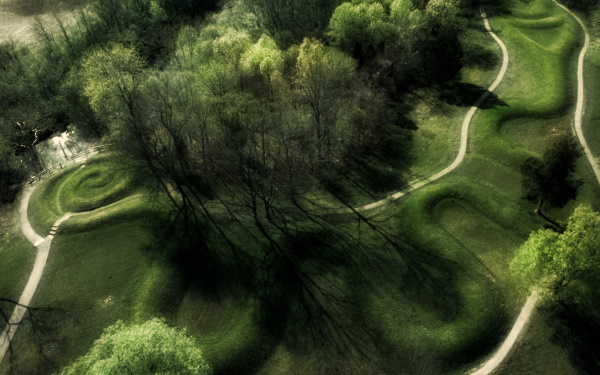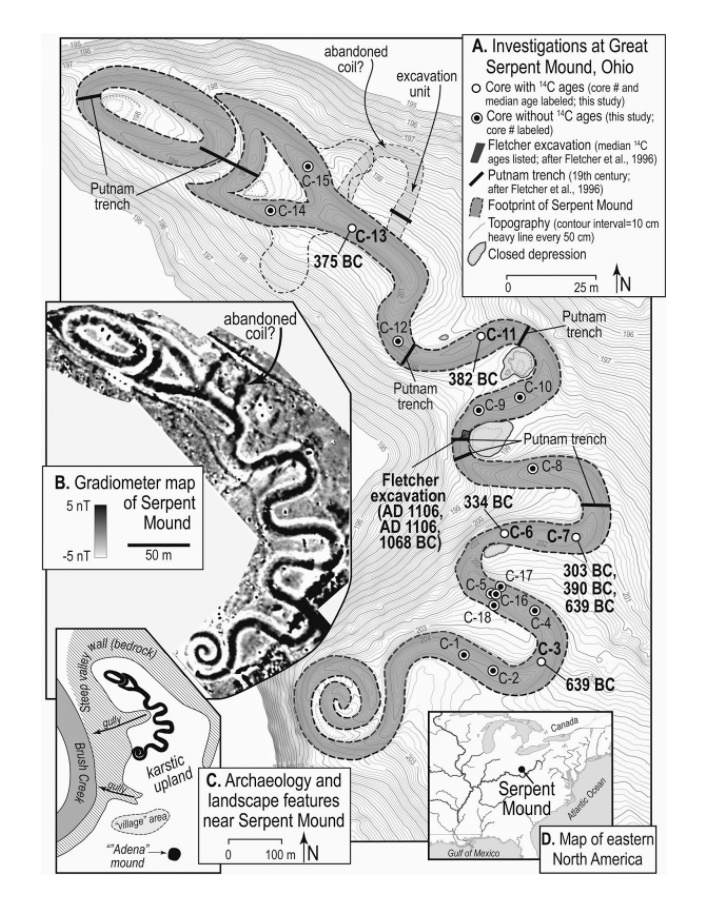The
Great Serpent Mound in Ohio is a 1,370 ft long prehistoric effigy mound
located near Peebles, Ohio. It is on the edge of a plateau that sits on
the southwest side of a meteor impact crater. It is 4.5 km across and
has powerful magnetic and gravitational anomalies contributing to it,
going deep into the even as far as the mantle. These anomalies cause
all sorts of weather fluctuations and earth effects in the form of
earth lights. As with many other mound sites, Serpent Mound was built
upon a powerful magnetic anomaly created by this prehistoric impact.

For
a long time conventional archaeology dated Serpent Mound to the Late
Woodland period of 1,070AD, but this is now almost unversally disputed
with recent radiocarbon analysis putting it at around 321 BC, one year
after the death of Aristotle. This puts it in the realm of the Adena
who were present in the area at this time. Ancient culture may have
helped to maintain the site, but were not the original builders.
The
coils of the serpent are aligned to the two yearly equinoxes and
solstices which makes the case that a massive terrestrial zodiac once
existed on the ground with the great serpent as the middle of it. A
similar zodiac is thought to exist around the legendary Glastonbury in
England.

(Larger View)Just
prior to 1891, Professor Putnam opened one of the burial mounds on the
property of the Great Serpent Mound. This account describes an Adena
male, six feet in length: "Several peculiarities of this skeleton are
worthy of notice. It was that of a well-developed man... and probably
about 25 or 30 years of age, he never had any wisdom teeth, and a
search in the maxillary bone of one side showed that there was no
wisdom tooth forming in the jaw. With this exception, he had a fine
set of teeth, and still embedded in the premaxillary bone is a partly
formed left incisor tooth. No corresponding formation can be seen on
the opposite side of the suture, and this is probably a super-numerary
tooth, although the small size of the lateral incisors is suggestive of
their being persistent first teeth. As is often the case in skulls
of this race, the crowns of the incisors are distinctly folded." This
indicates that a second-row of teeth could have been forming when he
died, suggesting he was an adolescent and may have grown much taller.
Very
close by this mound burial was another burial apparently of greater
antiquity than the Adena era, more typical of an archaic period trench
interment: The grave had been, all unwittingly, partly over an ancient
grave of particular interest. This older grave had been made about five
feet deep in the clay, and was about nine feet long and five wide. A
pavement of flat stones was placed over the bottom, and on them, at the
south side... were the fragments of a skeleton. The pieces of skull
found at the southeastern corner of the grave were twice the usual thickness.
Discoveries
near Serpent Mound, Ohio Dated March 5, 1894 "From the Indianapolis
Journal. Farmer Warren Cowen of Hilsborough, Ohio, while fox hunting
recently discovered several ancient graves. They were situated upon a
high point of land in Highland County, Ohio, about a mile from the
famous Serpent Mound, where Prof. Putnam of Harvard made interesting
discoveries. As soon as the weather permitted, Cowen excavated several
of these graves. The graves were made of large limestone slabs, two and
a half to three feet in length and a foot wide. These were set on edge
about a foot apart. Similar slabs covered the graves. A single one
somewhat larger was at the head and another at the foot. The top of the
grave was two feet below the present surface. Upon opening one of the
graves a skeleton of upwards of six feet was brought to light. There
were a number of stone hatchets, beads, and ornaments of peculiar
workmanship near the right arm. Several large flint spear and arrow
heads among the ribs gave evidence that the warrior had died in battle.
In another grave was the skeleton of a man equally large... Several
pipes and pendants were near the shoulders. In other graves, Cowen made
equally interesting finds. It seems that the region was populated by a
fairly intelligent people, and that the serpent mound was an object of
worship. Near the graves is a large field in which broken implements,
fragments of pottery, and burned stones give evidence of a prehistoric
village."